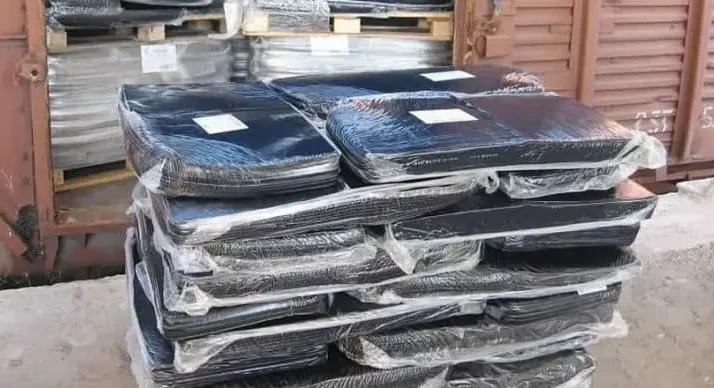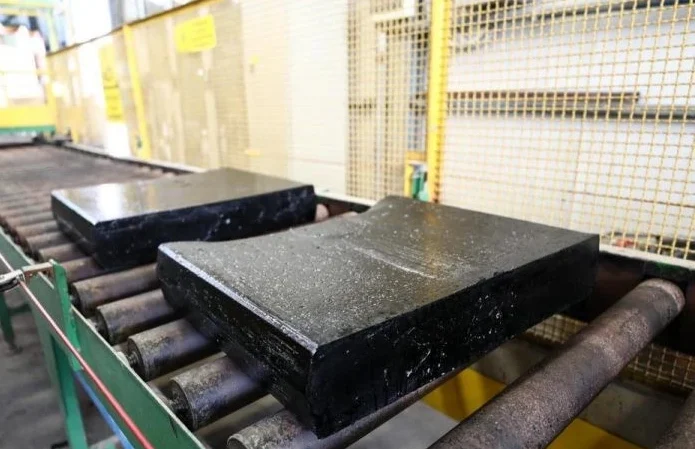 Oxidized bitumen 85/25
Oxidized bitumen 85/25
GENERAL INFORMATION OF OXIDIZED BITUMEN 85/25
Bitumen is hydrocarbon product produced by removing the lighter fractions (such as liquid petroleum gas, petrol and diesel) from crude oil during the refining process. In North America, Oxidized bitumen 85/25 is commonly known as asphalt binder or asphalt. Also, Bitumen is produced from petroleum and primarily used for the production of asphalt. Its consistency depends largely at hot temperatures it is viscous and larger chemical compounds such as aliphatic, petroleum resins, and asphaltenes move freely in the mass. Since asphalt and bitumen are used for road construction as well as for waterproofing work, the longest possible product lifetime is desirable. At the bitumen production reactor, during the air acting, the mixture of the two Vacuum Bottom (VB) and Vacuum Silas (VS) feedstock is put under a degree of pressure and temperature (between 200-300˚C) of which the hydrogen atoms content in the bitumen molecules oxidized, and obtains with higher hydrocarbons polymerization reaction that has lower penetration and higher softening points than the primary pure bitumen. This kind of bitumen 85/25 has the softening point of 85 and permeability of 25. Oxidized bitumen is characterized by being a product of great thermal amplitude. Oxidized bitumen has the flexibility to cold, has no sag at high temperatures and has good adhesion. It can be applied in any kind of work. Oxidized bitumen is available in many different grades.
TEST OF OXIDIZED BITUMEN 85/25 ON THE MIXTURE
The hardening due to the oxidation and evaporation of a thin film of Oxidized Bitumen 85/25 in contact with aggregate is assessed by two mixture tests: the hot mixture storage test and the change in the softening point of the bitumen during commercial asphalt manufacture. The hot mixture storage test simulates ageing conditions during mixing and hot storage. A prescribed mixture is manufactured in the laboratory, and a specifiedquantity of this mixture is stored for 16 h at 1608C in a sealed tin. Thus, the volume of air entrained in the sample is known and is constant from test to test. The bitumen is recovered from both the mixed and stored material, and the penetration and softening points are determined from samples of bitumen recovered from these two materials.
STANDARD SPEIFICATION TEST FOR BITUMEN 85/25
As a wide variety of bitumens is manufactured, it is necessary to have tests to characterise different grades. In several countries, the two tests often used to specify different grades of bitumen are the needle penetration test and the softening point test. Although they are both empirical tests, it is possible to estimate important engineering properties from the results, including high temperature viscosity and the stiffness modulus. The use of the penetration test for characterising the consistency of bitumen dates from the late nineteenth century.
USES OF OXIDIZED BITUMEN 85/25
Oxidized bitumen 85/25 uses in the chemical, fuel, paints, lacquers, varnishes, paper-pulp-board, textile processing, road construction, pavement ,crack seal and repairmen, civil works, roofing, construction industries; sealing and insulating buildings, adhesive, construction materials additive, dust-binding, insulating and impregnating agent, make rubber and plastic products. The oxidized bitumen 85/25 products are for paving. also used in asphalt-based paints for corrosion protection of metals, in lining public works structures, adhesives in electrical laminates, base for synthetic turf; typical uses for bitumen 85/25 used also for water-proof application and corrosion resistance for pipe coating, Portland cement pavement, hydraulic applications, paint manufacturing, caulking, mastics, and damp proofing. bitumen 85/25 is using insulation and isolation bitumen membrane sheet. Also, Car undercoating Automobile industry is specially required for Blown Asphalt. Vehicle undercoating material is based on Bitumen. Bitumen provides excellent waterproof, dust proof and noise proof for automobile undercoating. Oxidized Bitumen 85/25 is a solid or semi-black solid material and gradually liquid when heated. Oxidized Bitumen grades are blown or oxidized Asphalt ‘s which are produced by passing air through soft bitumen under controlled temperature conditions. This process gives the bitumen more rubbery properties than penetration or hard grade bitumens and a variety of uses in industrial applications. Oxidized Bitumen 85/25 is widely used as an anti-slip layer compound in the piling industry, for the manufacture of roofing felts, the roofing and waterproofing industries, for sound dampening felts and under carriage sealant in the automotive industry, electric cable joint protection, joint filling compound, carpet-backing, corrosion protection, acoustic panels, chemical, fuel, Manufacture of paints, sealant compound, and many others. Also used in sealing saw cuts and joints where expected movements are minimum. It is also used in the manufacturing of bituminous marine mastic for the oil & gas pipeline joints. Further, Oxidized Bitumen is used in the manufacture of bituminous marine mastic, which is required for the oil and gas pipeline joints.
- Oxidized bitumen is used as sealing of expansion joints.
- Oxidized bitumen is used as repair of joints or cracks.
- Oxidized bitumen is used as fixation of parquet floors.
- Oxidized bitumen is used as adhesive to be used in thermal insulation.
- Oxidized bitumen is used as repair of unexposed cracks.
- Oxidized bitumen is used as bonding of wet briquettes
- Oxidized bitumen is used in various industries like roofing, isolation, insulation flooring, mastics, pipe coatings, electrical applications.
APPLICATION OF OXIDIZED BITUMEN 85/25
Bitumen 85/25 is produced by either Continuous or Staggered Blowing Process. Heated Penetration Grade Bitumen under controlled environment is blown with air which controls the Oil Content in the Bitumen while it oxidized. The different grades for suited applications produced are designated by two numbers to indicate the mid-points of their softening point and penetration ranges. The Oxidized Bitumen 85/25 should be heated double temperature against the softening point to be able to have flow and viscosity. Surfaces must be dry, clean and free of loose particles, formwork, curing products, irregularities, slurry, etc.
TECHNICAL ADVANTAGES OF OXIDIZED BITUMEN 85/25
- Durability
- Flexibility
- Water Resistant
- Chemical Stability
COMPARED TO PAVING GRADE BITUMEN:
- Reduced temperature susceptibility
- Exhibits a more ‘solid’ nature at ambient temperatures
- High penetration index
RECOMMENDATIONS FOR HANDLING/STORAGE
Heating of packaged bitumen is a critical phase in most of the final uses. Typically, the packaged material is heated and melted in boilers out on site. However, control at the heating phase is very important in terms of health and safety as well as in maintaining the quality of the product. Note must be taken of the maximum safe handling temperature of 230 C and this should not be abused. Bitumen is a poor conductor of heat, consequently, control of the heating phase is of paramount importance. The Oxidized Bitumen material should be broken up prior to placement in the boiler. This exposes a larger surface area to the heat and encourages a more even heating regime. Without the larger exposed surface area, aggressive heating at the base and sides of the boiler may well result in localized overheating, altering the characteristics of the modified bitumen and potentially causing thermal cracking of the bitumen, creating the release of low lash vapors. The flash point of the oxidized bitumen then becomes irrelevant; as these low flash vapors determine the fire risk. Melted bitumen should not be left in the boiler and reheated from cold, as there is then a high potential for localized overheating around the heating area (lack of convection means poor heat transfer) and potential development of a pressurized pocket of low flash vapors. Be aware of the placement of any temperature monitoring or control devices. As a result of the poor thermal conductivity of the bitumen, a thermometer in the bitumen some distance from the heat source could read significantly different (even hundreds of degrees) from the true temperature of the bitumen near the heat source.
HEALTH & SAFETY
Workers should wear protective masks, gloves, and goggles during application. The asphalt can be removed from equipment and tools with kerosene or gasoline. Care should be taken when heating Oxidized Bitumen 85/25 to avoid overheating.
For Health and Safety information, please make reference to the relevant MSDS.
PACKING OF OXIDIZED BITUMEN 85/25
 Packing of Oxidized bitumen 85/25
Packing of Oxidized bitumen 85/25
Blown Asphalt 85/25 in various packing, including bitumen 85/25 is available in 20 & 50 Kg Kraft Paper Bags 25 Kg Carton box & 150, 180, 200 Kg Steel Drums.
25 KG CARTON BOX
25 KG MOLD PACKING: It is most expensive packing since there is mold on and with same mold we can ship out. The mold is carton and at destination you can remove the mold easily.
25 KG POLYAMIDE BAG: It is heat resistance bag and filling directly in water to cool down fast. It is firstly use not possible to take out the Polyamide from the bitumen and then use.
25 KG CRAFT BAG: Craft bag is recycle packing and inside is special material to prevent sticking the bitumen to bag. This grade also possible to load on pallet or without pallet for customer.
TECHNICAL DATA SHEET OF OXIDZED BITUMEN 85/25
BITUMEN 85/25 TEST METHOD UNIT SPECIFICATION
Specific gravity @ 25/25 °c ASTM D70 Kg/cm³ 1.05 approx
Penetration @ 25°c ASTM D5 mm/10 20-30
Softening point °c ASTM D36 °C 80-90
Ductility @ 25°c ASTM D113 cm 3 min
Loss on heating(wt) % ASTM D6 wt % 0.2 max
Flashpoint °c ASTM D92 °C 250 min
Solubility is CS2(wt) % ASTM D4 wt % 99.5 max
Spot test A.A.S.H.O.T 102 - Negative
For more information, please Contact our Sales Team.

